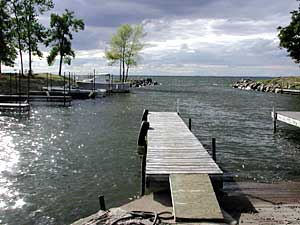|
Audio
Photos
Your Voice
|
How many walleye does catch and release kill?
October 6, 2003
 |
| Many walleye boats launch from Agate Bay, a popular resort area on Mille Lacs. (Annie Baxter) |
Garrison, Minn. — On Mille Lacs Lake, the advent of fall comes in gusty winds and rough waves. It's known in these parts as "walleye chop."
 | |||
Twenty-four year old Chris Longhenry's aluminum boat plies the water. It's not fish he's after today, it's volunteers. He's a clerk for the DNR's hooking mortality study. And his job is to solicit anglers to catch fish, and help figure out what happens to them from that moment on.
"For every volunteer we give them a sample data sheet so they know what kind of questions we're going to be asking when we pull up to get the fish," Longhenry says. "We give them a horn to signal us to get the fish, a stopwatch to time how long it takes to get the fish from their landing net into the tub we give them, and then also how long after that it takes to come and pick up the fish."
Then the fish are returned to Mille Lacs but held in a net cage under water for five days. That's about how long biologists think it would take for a stressed fish to die.
Keith Reeves is a biologist with the DNR. He says it was important to put the DNR's observations about hooking mortality to a rigorous test.
"Last year hooking mortality accounted for more than half of the total harvest," he says. "We wanted to find out if that number was accurate."
 | |||
Reeves notes that many factors affect a fish's chance of survival. "Temperature, depth, what bait was used, where the fish was hooked, and how long was it held out of water," he offers.
Reeves says they're keeping track of all those things at once.
But science alone doesn't drive the study. It's important to have accurate numbers about the fish kill for political reasons. That's because the Mille Lacs Band of Ojibwe has rights to harvest on the lake. The band kept those rights when they signed a treaty with the state in 1837. A Supreme Court ruling in 1999 upheld the treaty.
The Mille Lacs Band takes an active role in managing the lake. And the walleye mortality study will help detemrine the appropriate harvest levels for the Ojibwe and non-Indian anglers.
 | |||
Curt Kalk is Commissioner of Natural Resources for the Mille Lacs Band. He thinks the walleye mortality study will be useful to all parties that hold an interest in the lake.
"The more information we have on the lake and what the impact is of public pressure and fishing on it ... all that helps us decide what a safe harvest level is," Kalk notes.
The study promises to be of interest elsewhere in the state as well. Ron Bayer is the DNR's Commissioner of Fisheries.
"We're looking at times where we're seeing increased amounts of of voluntary and regulatory selective harvest," Bayer says. "This will help us get a grasp on what the hooking mortality is and to maybe work with anglers to do a better job when we release the fish."
 | |||
At Agate Bay on Mille Lacs, angler Chuck Quigley is about to head out in his boat. He'd love to be able to keep more fish than the current limits allow. If biologists find fewer fish are dying because of catch and release than they've thought, that might happen.
"It would help the local economy if people could keep more fish, " Quigley remarks.
If there is an effect on regulations, it will probably not be immediate. But in the meantime, the DNR biologists will get a better sense of how catch and release is best practiced. They know some fish will die. But the data they record now might help them reduce the mortality rates.
|
News Headlines
|
Related Subjects
|
